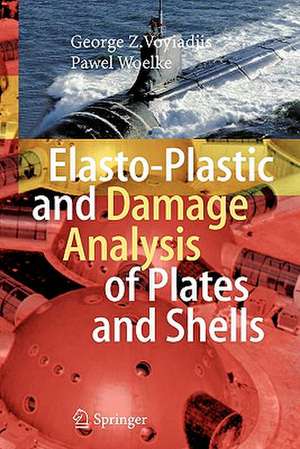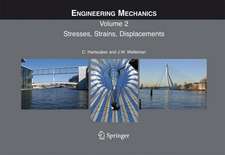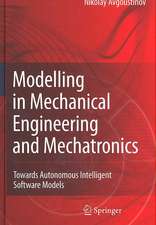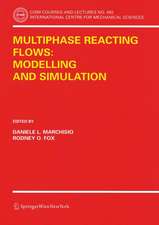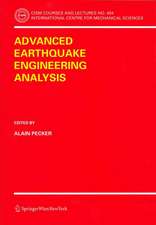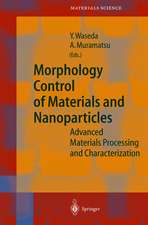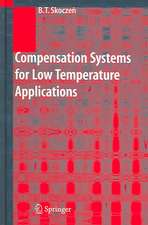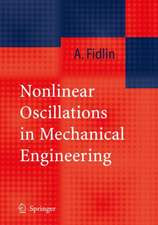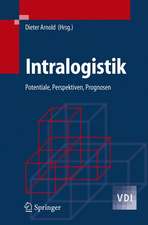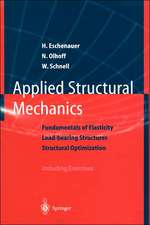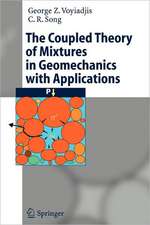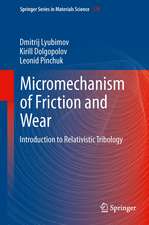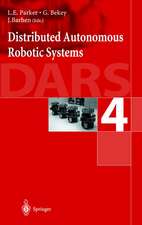Elasto-Plastic and Damage Analysis of Plates and Shells
Autor George Z Voyiadjis, Pawel Woelkeen Limba Engleză Paperback – 18 oct 2010
| Toate formatele și edițiile | Preț | Express |
|---|---|---|
| Paperback (1) | 941.05 lei 6-8 săpt. | |
| Springer Berlin, Heidelberg – 18 oct 2010 | 941.05 lei 6-8 săpt. | |
| Hardback (1) | 948.16 lei 6-8 săpt. | |
| Springer Berlin, Heidelberg – 18 aug 2008 | 948.16 lei 6-8 săpt. |
Preț: 941.05 lei
Preț vechi: 1147.63 lei
-18% Nou
Puncte Express: 1412
Preț estimativ în valută:
180.07€ • 188.51$ • 148.100£
180.07€ • 188.51$ • 148.100£
Carte tipărită la comandă
Livrare economică 05-19 aprilie
Preluare comenzi: 021 569.72.76
Specificații
ISBN-13: 9783642098222
ISBN-10: 3642098223
Pagini: 224
Ilustrații: XIV, 208 p.
Dimensiuni: 155 x 235 x 12 mm
Greutate: 0.32 kg
Ediția:Softcover reprint of hardcover 1st ed. 2008
Editura: Springer Berlin, Heidelberg
Colecția Springer
Locul publicării:Berlin, Heidelberg, Germany
ISBN-10: 3642098223
Pagini: 224
Ilustrații: XIV, 208 p.
Dimensiuni: 155 x 235 x 12 mm
Greutate: 0.32 kg
Ediția:Softcover reprint of hardcover 1st ed. 2008
Editura: Springer Berlin, Heidelberg
Colecția Springer
Locul publicării:Berlin, Heidelberg, Germany
Public țintă
ResearchDescriere
Shells and plates are critical structures in numerous engineering applications. Analysis and design of these structures is of continuing interest to the scienti c and engineering communities. Accurate and conservative assessments of the maximum load carried by a structure, as well as the equilibrium path in both the elastic and inelastic range, are of paramount importance to the engineer. The elastic behavior of shells has been closely investigated, mostly by means of the nite element method. Inelastic analysis however, especially accounting for damage effects, has received much less attention from researchers. In this book, we present a computational model for nite element, elasto-plastic, and damage analysis of thin and thick shells. Formulation of the model proceeds in several stages. First, we develop a theory for thick spherical shells, providing a set of shell constitutive equations. These equations incorporate the effects of transverse shear deformation, initial curvature, and radial stresses. The proposed shell equations are conveniently used in nite element analysis. 0 AsimpleC quadrilateral, doubly curved shell element is developed. By means of a quasi-conforming technique, shear and membrane locking are prevented. The element stiffness matrix is given explicitly, making the formulation computationally ef cient. We represent the elasto-plastic behavior of thick shells and plates by means of the non-layered model, using an Updated Lagrangian method to describe a small-strain geometric non-linearity. For the treatment of material non-linearities, we adopt an Iliushin’s yield function expressed in terms of stress resultants, with isotropic and kinematic hardening rules.
Cuprins
Shell Constitutive Equations.- Shell Element Based on the Refined Theory of Thick Spherical Shells.- Geometrically Non-linear Finite Element Analysis of Thick Plates and Shells.- Elasto-Plastic Geometrically Non-linear Finite Element Analysis of Thick Plates and Shells.- Elasto-Plastic Geometrically Non-linear Finite Element Analysis of Thick Plates and Shells With Damage Due to Microvoids.- Non-linear Post Buckling Finite Element Analysis of Plates and Shells.- Determination of Transverse Shear Stresses and Delamination in Composite Laminates Using Finite Elements.- Numerical Methods and Computational Algorithms.
Textul de pe ultima copertă
This book presents a finite element model for the elasto-plastic and damage analysis of thin and thick shells. Linear elastic, inelastic and softening behaviors caused by damage in structural shells, as well as large rotations are investigated. The textbook is addressed to graduate students and researchers in civil, mechanical and aerospace engineering as well material scientists and applied mechanicians.
The formulation presented here was developed primarily for large scale structural analyses. Special emphasis is therefore placed in computational efficiency. Despite ever increasing capabilities of nowadays computers, small scale constitutive models are hardly ever applicable to analysis of large structures. This book provides a constitutive model which allows for accurate representation of the non-linear shell behavior up to failure, while offering high efficiency and applicability to large scale structural analyses. This is achieved by representing the elasto-plastic behavior by means of the non-layered approach, with an updated Lagrangian method used to describe the geometric non-linearities. For the treatment of material non-linearities an Iliushin’s yield function expressed in terms of stress resultants is adopted, with isotropic and kinematic hardening rules. Damage effects modeled through the evolution of porosity are incorporated into the yield function, giving a generalized and convenient yield surface expressed in terms of the stress resultants.
The formulation presented here was developed primarily for large scale structural analyses. Special emphasis is therefore placed in computational efficiency. Despite ever increasing capabilities of nowadays computers, small scale constitutive models are hardly ever applicable to analysis of large structures. This book provides a constitutive model which allows for accurate representation of the non-linear shell behavior up to failure, while offering high efficiency and applicability to large scale structural analyses. This is achieved by representing the elasto-plastic behavior by means of the non-layered approach, with an updated Lagrangian method used to describe the geometric non-linearities. For the treatment of material non-linearities an Iliushin’s yield function expressed in terms of stress resultants is adopted, with isotropic and kinematic hardening rules. Damage effects modeled through the evolution of porosity are incorporated into the yield function, giving a generalized and convenient yield surface expressed in terms of the stress resultants.
Caracteristici
Recent advances on the theory of plates and shells
